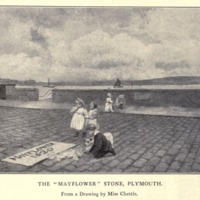Description
Marcus Huish, writing in 1907, visits the recently installed Mayflower Stone in Plymouth. The scene is again illustrated by Elizabeth Chettle, showing children laying flowers near the memorial; a visual embellishment rich in pathos:
"It was not until the 6th September, O.S., that the Mayflower all troubles having apparently blown over, put to sea again before a prosperous wind with a company of 104 persons. The ancient Cawsey from which they went on board has disappeared, but the site has always been known, and in 1891 a tablet was placed in the sea-wall, as shown in Miss Chettle's illustration […] The voyage was a very stormy one; "oftentimes the winds were so fierce, and the seas so high, that they could not bear a knot of sail, and were forced to hull for days together." Once at least there was a question whether the wiser course would not be to return; but at last, after sixty-seven days, by God's good providence they got into Cape Cod harbour. This being without the limits of the Virginia Colony, they deemed themselves at liberty to sign a new contract of government, which they did, electing John Carver governor. Coasting along, they finally, on 11th December, decided to settle at Plymouth, as they christened the harbour at the farther end of the great bay formed by Cape Cod."

